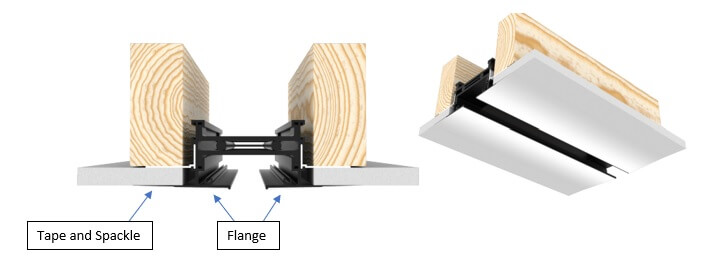How to Prevent Thermal Expansion and Contraction in HVAC Grilles, Registers, and Diffusers (GRD)

What if the occupants of a newly constructed building hear clicking or popping noises coming from the linear diffusers as the air conditioning is cooling the space? This issue can be frustrating, and it's important to understand why this situation can occur and how to prevent it from happening. In the second of our two-part blog series, we’ll explore the effects of thermal expansion and contraction on grilles, registers and diffusers (GRDs).
What is Thermal Expansion and Contraction?
An issue that can occasionally arise in HVAC design is when a long HVAC grille or linear diffuser is installed and begins to pop or creak while the air conditioning is running. These sounds could be caused by thermal stresses within the linear diffuser due to the unit expanding or contracting. Since the majority of HVAC grilles and diffusers are made of metal, and most linear diffusers in the market are made of aluminum, thermal expansion is an important factor to consider. In general, metals can expand or contract in size when subjected to large temperature changes. Each material has its own unique ‘coefficient of thermal expansion.’ The coefficient of thermal expansion’ (CTE) is defined as how much a material will expand/contract in size per each degree of temperature change.
Thermal expansion/contraction is typically unnoticeable on a relatively small product, but over a long length, it becomes a factor that must be considered. In general, linear slot diffusers are made of aluminum, which has a larger thermal expansion coefficient than steel, and this can amplify the issue. If the unit was installed in an unconditioned space with a temperature of 90°F, but then the air conditioning is turned on and set to 65°F, this 25-degree difference in temperature will cause the unit to contract in length. Depending on how large the temperature difference is will determine the extent of the thermal expansion/contraction.
When a material is constrained in one or more dimensions, and is then subjected to a large temperature difference, this will lead to large ‘thermal stresses’ within the material. These thermal stresses will increase as the internal temperature of the material changes. In an HVAC application, flowing hot/cold air through a metal product will facilitate the heat transfer that changes the internal temperature of the material. If the thermal stress becomes too high, it can cause cracking, buckling, bending, or can cause sudden movements that can manifest as popping, clicking, or creaking noises.
Explaining Thermal Expansion and Contraction with Physics
For example, to put this into perspective, let’s imagine you just installed a linear diffuser that is 96-inches long in a single section. A linear diffuser is typically made of several assembled components. These components include the frame, the spacer blocks, and internal components called ‘pattern controllers’ which help to direct the air in specific directions. These pattern controllers are usually able to be adjusted and moved by an occupant to change the airflow pattern.
If you install this linear in 90°F temperatures, but the air conditioning provides 65°F air to the unit, the temperature of the material will begin to cool down until it eventually reaches the air temperature of 65°F. This 25-degree negative temperature difference is the driving force behind the contraction of the linear diffuser.
Aluminum has a coefficient of thermal expansion of 13.1x10-6 in/in.°F. This means that for every degree of temperature difference, the unit’s length will change by 0.0131%.
Using this coefficient, it’s possible to calculate how much the linear will contract due to the temperature difference it is experiencing.
Example
Temperature Difference = ΔT = Tfinal - Tinitial
Temperature Difference = 65°F – 90°F = -25°F
Initial Length = Linitial = 96 inches
Aluminum Coefficient of Thermal Expansion = CTEAluminum = 13.1x10-6 in/in.°F
Total Change in Length = LInitial * CTEAluminum * ΔT
Total change in Length = 96 in * (13.1x10-6 in/in.°F) * -25°F= -0.03144 inches
New Overall Length = 96 inches – 0.03144 inches = 95.9685 inches
After thermal contraction, the length of the linear diffuser only changed by a fraction of an inch, but it decreased by about 1/32” which wasn’t accounted for when it was installed. This would usually not pose a problem if the linear is mounted in a way that allows slight movement. However, if the linear is installed very securely and constrained with no ability to expand or contract, then the thermal stresses will begin to build up in the unit’s material. Since the separate components that comprise a linear diffuser could be different thicknesses or even different types of material, this means that each of them could experience a unique amount of thermal expansion depending on the temperature.
For example, since the pattern controllers in a linear diffuser are exposed directly to airflow, these components could cool down or heat up faster than the frame material in the product. As thermal stresses build up between components within the linear, these stresses will continue to increase until they release their energy by sudden movements, and this would manifest as clicks, creaks, or loud popping noises. In other situations, if the unit is unable to move at all on either end and the thermal stresses continue to increase, then this can cause buckling, cracking, or bending of the material in extreme situations.
Another situation to consider is if the linear diffusers are ‘tape and spackled’ into a sheetrock ceiling. In this case, the perimeter flanges of the linear are covered in spackle to help blend the linear diffusers into the sheetrock ceiling to conceal the metal frame. This leads to a clean installation with only the slot opening visible with the unit being spackled into place. When the tape/spackle dries it becomes very brittle. If this unit is subjected to a large temperature difference and the unit begins to contract or increase in length, the tape and spackle finish could begin to crack along the length as the metal flange underneath begins to stretch or contract. To ensure that thermal expansion/contraction does not pose an issue, one can follow a few steps that can greatly reduce the possibility of this occurring.
 |
| Figure 1: Linear Slot Diffuser installed in sheetrock ceiling with tape and spackle flange |
How to avoid thermal expansion/contraction issues in the field
Thermal expansion/contraction is a rare problem to encounter in the field but there are a couple of important steps that one can take to avoid this from happening. The key is to avoid large temperature differences between the installation temperature and the normal average working temperatures.
Sometimes, HVAC grilles or components could be kept outside at a job site or in a location that reaches higher temperatures, such as 90-100°F before they are installed. If the unit is installed while it still retains this high temperature, and then cold air is supplied through the unit, there could be problems related to thermal expansion or contraction. In this case, the unit could be subjected to a temperature difference of 40-50 degrees and this can create large thermal stresses and strains that can cause the aforementioned popping or creaking noises. To avoid this, contractors need to keep the products in the shade, or indoors, before installation. If this is not possible, the units should be put aside for them to cool down before they are installed.
The best solution would be to install the linear diffusers at a temperature that’s within 10-15 degrees of the intended working temperature of the space to minimize the maximum temperature difference. For example, if the plan is to keep the supply air temperature at 72°F during working conditions, then installing the unit at a temperature between 62-82°F will ensure that there’s a low probability of having thermal expansion-related clicking/popping sounds. Ideally, one would want to ensure that the installed unit will not be subjected to a temperature difference of more than 15 degrees from when it is installed. Or if it’s known that the unit will be subjected to large temperature differences, one should mount them in a way that allows for slight expansion or contraction to minimize the buildup of internal stresses. There can also be similar thermal issues if the unit is installed in very cold environments, and then hot air is supplied through the unit during heating mode. The only difference is that in this example, the unit will increase in length instead of contracting in length. The solution however is the same; the unit should be installed at a temperature close to the desired working temperature of the space.
Thermal expansion/contraction can be a frustrating issue for contractors and occupants of new buildings. Hearing popping noises can be annoying, but by following the steps above, you can greatly reduce the chance of those issues occurring.
For more information on GRD products, click here or contact your nearby Greenheck representative.
To read part one of this two-part series, How to Prevent Condensation in HVAC Grilles, Registers, and Diffusers (GRD), click here.
Grilles, Registers & Diffusers


from